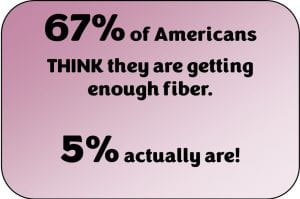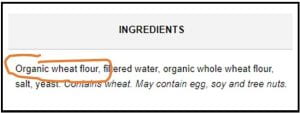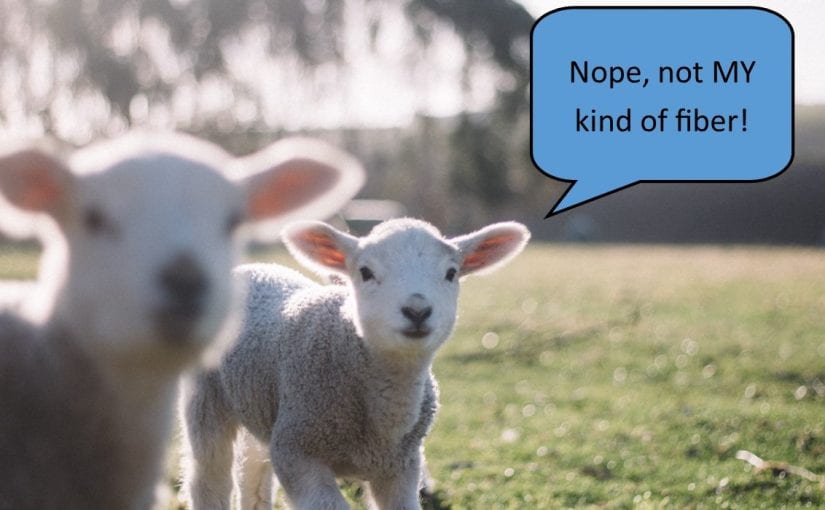When I say “fiber”, what is the first thing that comes to mind?
I’m guessing it will be wool or cotton or maybe polyester; or something similar to the definition found in Wikipedia, where they go on to describe natural and synthetic fibers that make up textiles, paper, optical fibers, asbestos…
But folks, what I want to talk about is dietary fiber. Because most Americans aren’t meeting the recommended minimum fiber intake.
Are you eating enough fiber?
The Dietary Guidelines for Americans have identified fiber as a “nutrient of concern” since 2005.
When I say “most Americans” are not eating enough fiber, I’m talking 95% (!) of us, according to the “What We Eat in America” National Health and Nutrition Examination Survey (NHANES) 2009-2010.
This is a major disconnect from our beliefs about our diet: 67% of us think we are eating an adequate amount of fiber, according to the 2013 International Food Information Council Functional Foods Consumer Survey.
 In the “What We Eat in America” NHANES 2017-2020 Prepandemic, the data shows that on average people ages 2-19 are getting 14.1 grams of fiber daily, and age 20 and over are getting 16.6 grams. Peek ahead to see the “Recommended daily intake for fiber” and compare the numbers!
In the “What We Eat in America” NHANES 2017-2020 Prepandemic, the data shows that on average people ages 2-19 are getting 14.1 grams of fiber daily, and age 20 and over are getting 16.6 grams. Peek ahead to see the “Recommended daily intake for fiber” and compare the numbers!
So, are YOU eating enough fiber? Let’s explore this together.
First off, what is dietary fiber anyway?
Fiber is a carbohydrate that we are not able to digest or absorb. Dietary fiber comes from plant—not animal—sources: whole vegetables, whole fruits, and whole grains. Types of dietary fiber you may have heard of in ingredient lists include cellulose, inulin, pectin, and carrageenan—but getting fiber from whole foods is a better choice than extracts.
Why is fiber so important?
Fiber rates as a “nutrient of concern” because it does so many good things for us when we get enough of it:
- It helps us maintain a healthy weight.
- It helps control our blood sugar levels.
- It helps lower cholesterol levels.
- It prevents constipation.
Fiber slows down digestion, which keep blood sugar from rising too quickly, which can be especially important for those with diabetes. It also keeps us feeling fuller, so we don’t get hungry between meals. Less snacking = less chance of excess calories. Soluble fiber (dissolves in water) forms a gel that binds to LDL cholesterol in the intestine and ferries it out of your system before it gets into the blood stream. Insoluble fiber acts like a scrub brush as it passes basically intact through your stomach, small intestine, and colon before it passes out of your body.
In short: a high fiber diet is associated with reduced risk of obesity, type 2 diabetes, cardiovascular disease, and cancer.
Recommended daily intake for fiber
As a general rule, you should be aiming for 14 grams of fiber for every 1000 calories. Your recommended calorie intake varies with your age, sex, activity level, and any weight change goals. However, this chart gives the National Academy of Medicine’s Recommended Daily Intake for Fiber.
| Age | Recommended minimum intake |
| Toddlers (1-3 years old) | 19 grams |
| Children (4-8 years old) | 25 grams |
| Girls and teen girls (9-18 years old) | 26 grams |
| Women (19-50 years old) | 25 grams |
| Women (51+ years old) | 21 grams |
| Boys (9-13 years old) | 31 grams |
| Teen boys and men (14-50 years old) | 38 grams |
| Men (51+ years old) | 30 grams |
Some good sources of fiber
As I mentioned earlier, the whole plants that we eat—veggies, fruits, and grains—are our sources of fiber. Some give us a bit more fiber than others, but “eating the rainbow” of veggies and fruits is the best idea: it gives a variety of vitamins and minerals while also providing fiber. Reminder: most teens and adults should be aiming for at least 2 ½ to 3 cups of veggies a day, and 1 ½ to 2 cups of fruit, so make half your plate veggies and fruits at every meal or snack.
Below are the amounts of fiber in some popular plant-based foods. You can explore more good sources of fiber at www.dietaryguidelines.gov/resources/2020-2025-dietary-guidelines-online-materials/food-sources-select-nutrients/food-0.
| Popcorn | 3 cups | 5.8 grams |
| Ready-to-eat shredded wheat cereal | 1 cup | 6.2 grams |
| Whole wheat crackers | 1 ounce | 2.8 grams |
| Navy beans | ½ cup | 9.6 grams |
| Lentils | ½ cup | 7.8 grams |
| Broccoli | 1 cup | 5.2 grams |
| Carrots (cooked) | 1 cup | 4.8 grams |
| Baked potato (with skin) | 1 medium | 3.9 grams |
| Red bell pepper (raw) | 1 cup | 3.1 grams |
| Raspberries | 1 cup | 8.0 grams |
| Banana | 1 medium | 3.2 grams |
| Blueberries | 1 cup | 3.6 grams |
| Almonds | 1 ounce | 3.5 grams |
| Pumpkin seeds | 1 ounce | 5.2 grams |
YUMMY sources of dietary fiber
Getting fiber in your diet doesn’t have to be complicated. Here are some simple ways to eat more fiber:
- Have baby carrots with hummus as a snack
- For breakfast, make oatmeal topped with your favorite fruit
- When making a sandwich, use whole wheat bread
- Get your burrito filled with black beans instead of chicken or beef
- Add a handful of beans to your green salad
- When baking, replace half the white flour with whole wheat flour
- Order brown rice instead of white rice with your Chinese food takeout meal
- Have some chips with salsa instead of onion dip
- Have that slice of pizza with broccoli as a topping instead of pepperoni
What else should I know?
If you’re not used to getting a lot of fiber in your diet, don’t go whole hog right away or you’re likely to cause digestive issues (think gas, bloating, and cramps). Be gentle on your body and increase your intake gradually.
Stay hydrated! When you increase your dietary fiber, be sure to also increase your water intake.
Fruit and vegetables juices do not contain fiber. Eat the whole fruit or vegetable instead. For example, to get fiber, eat an orange instead of drinking orange juice.
Not sure if that bread or cereal or crackers is a whole grain product? Check the first ingredient. Most of the time, if it doesn’t say “whole”, it probably isn’t—look for “whole wheat” or “whole ground corn,” for example.


- If it says “enriched flour,” it’s not whole grain.
- If the word “whole” is in the second (or third or fourth…) ingredient, it’s also not a whole grain product (it just contains some whole grains).
- Happily, some grain products are almost always whole grains: oats and quinoa, for example.
- Brown rice is whole grain, but white rice is not. Hulled barley is, and pearled barley is not.
Keep the skin on when you can.
| Apples | 1 cup | No skin = 2.4 grams | With skin = 3.7 grams |
| Potatoes | 1 cup | No skin = 2.0 grams | With skin = 5.0 grams |
Want to learn more?
Getting enough fiber is just one part of healthy eating and a healthy lifestyle. Our nutrition education-cooking classes are offered in person at our Cobleskill, Cooperstown, and Oneonta outreach offices, at spaces provided by partner organizations around both counties, and via Zoom. We are also able to work one-on-one with individuals and families!
Contact one of our nutrition educators to let us know about your interest. We look forward to working with you! Michelle Leveski, mml39@cornell.edu, 518-234-4303 ext. 115, or Kimberly Ferstler, kmf239@cornell.edu, 518-234-4303 ext. 120

